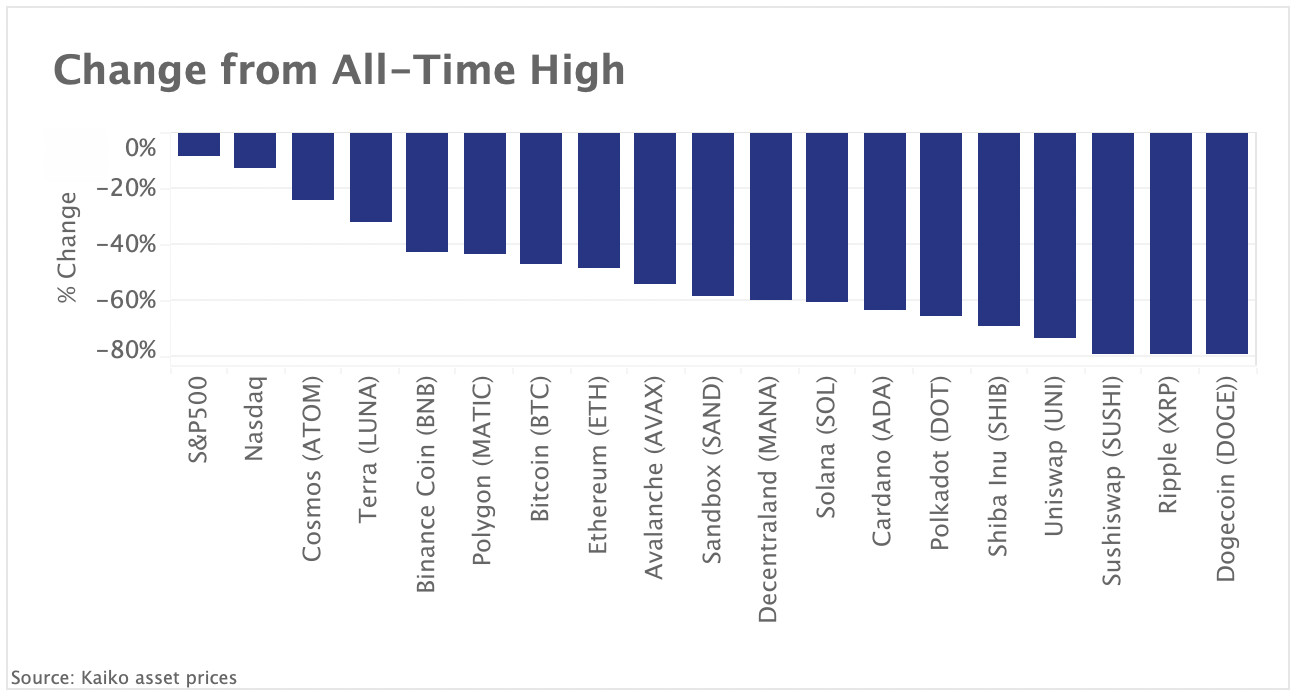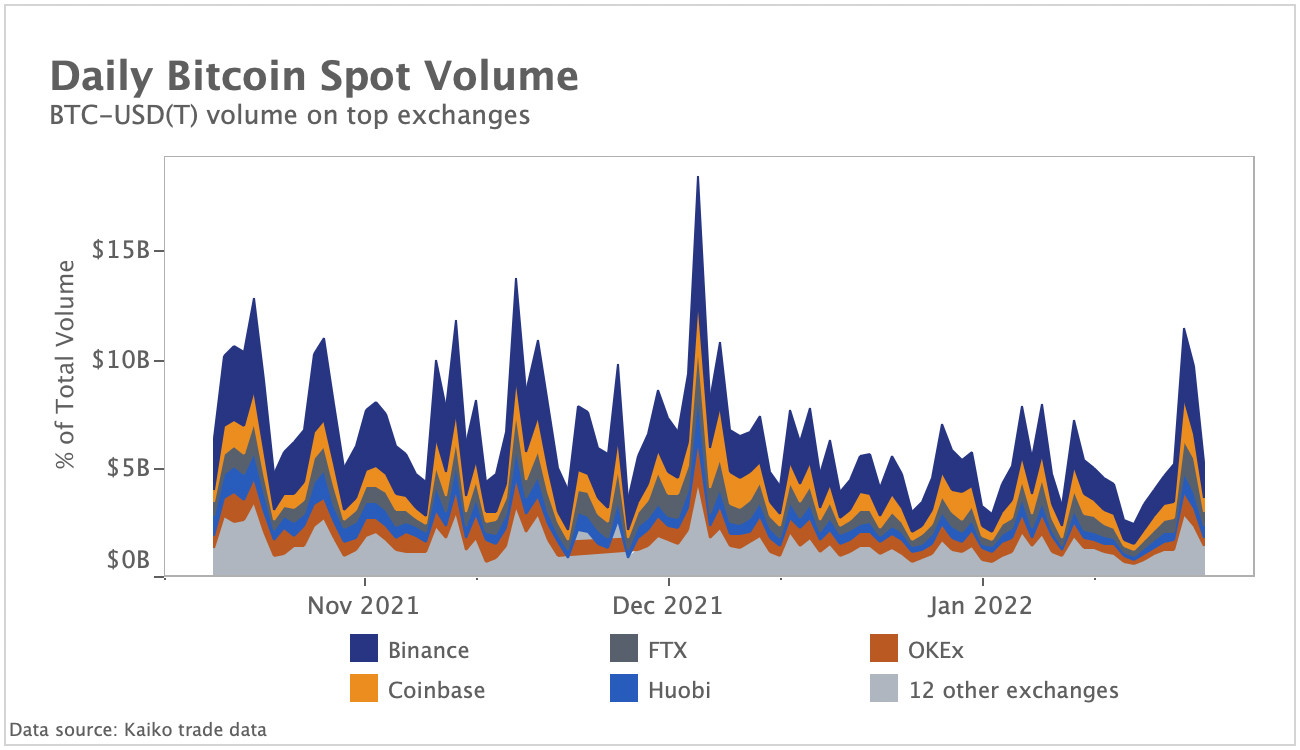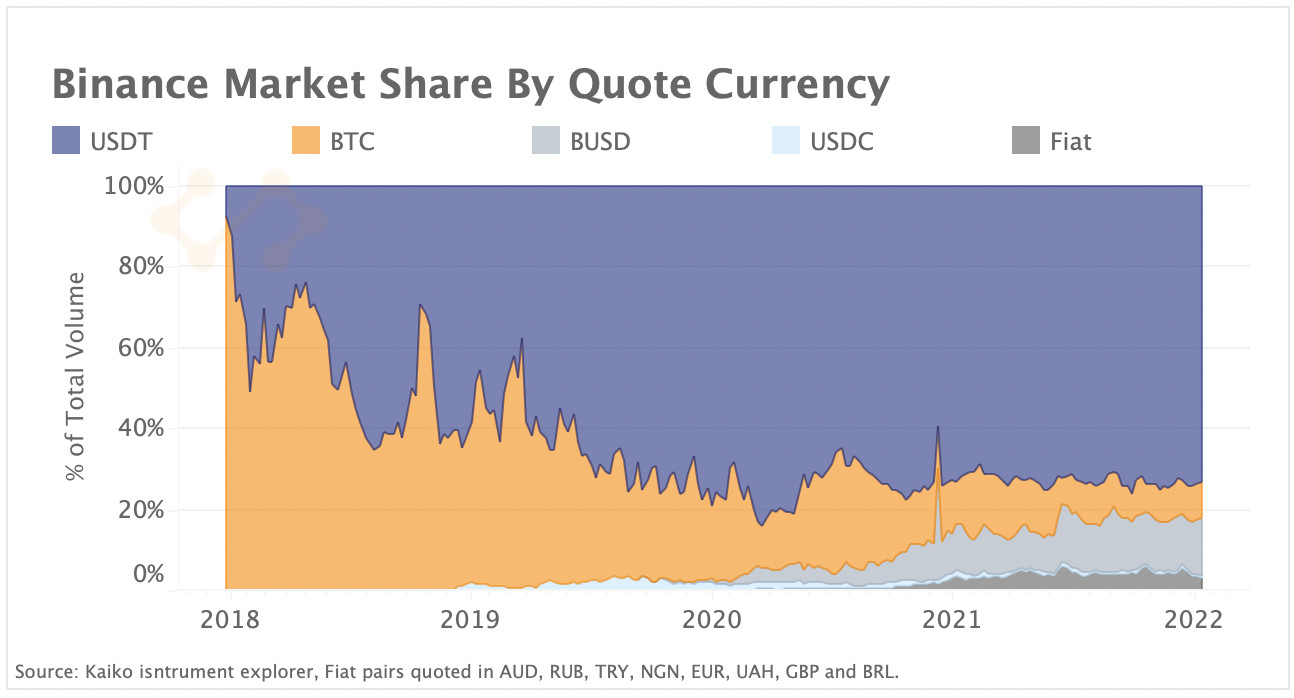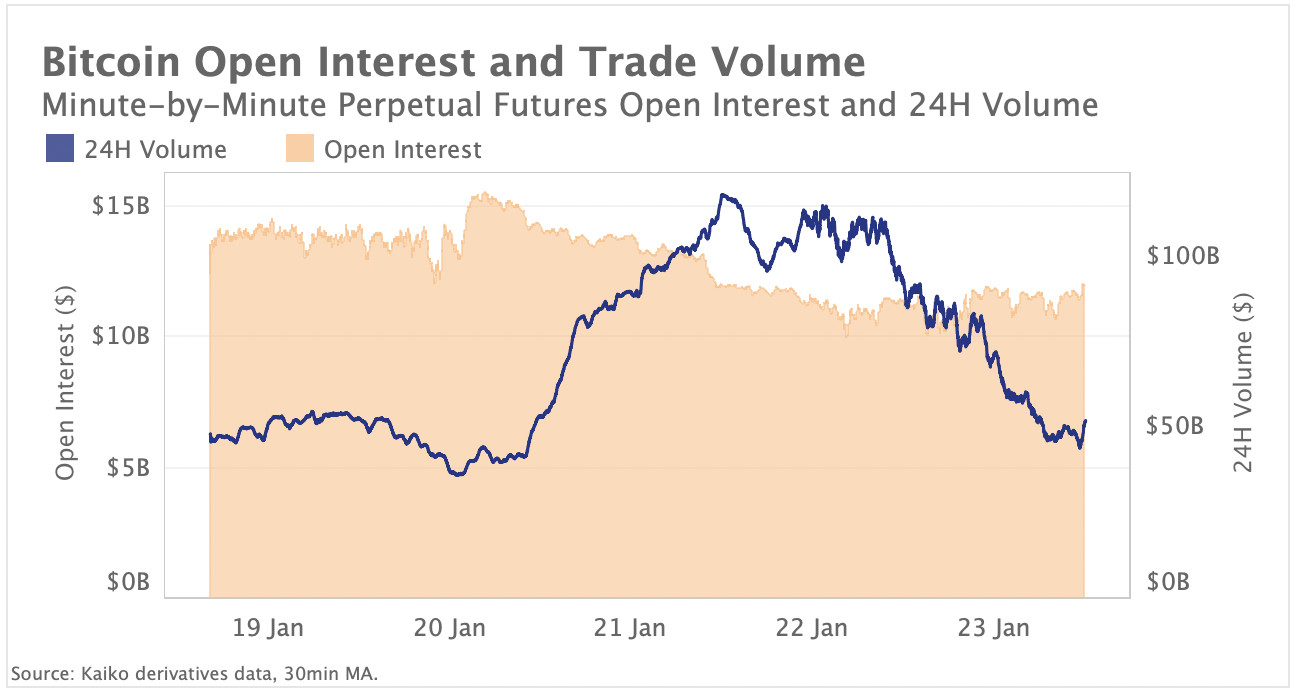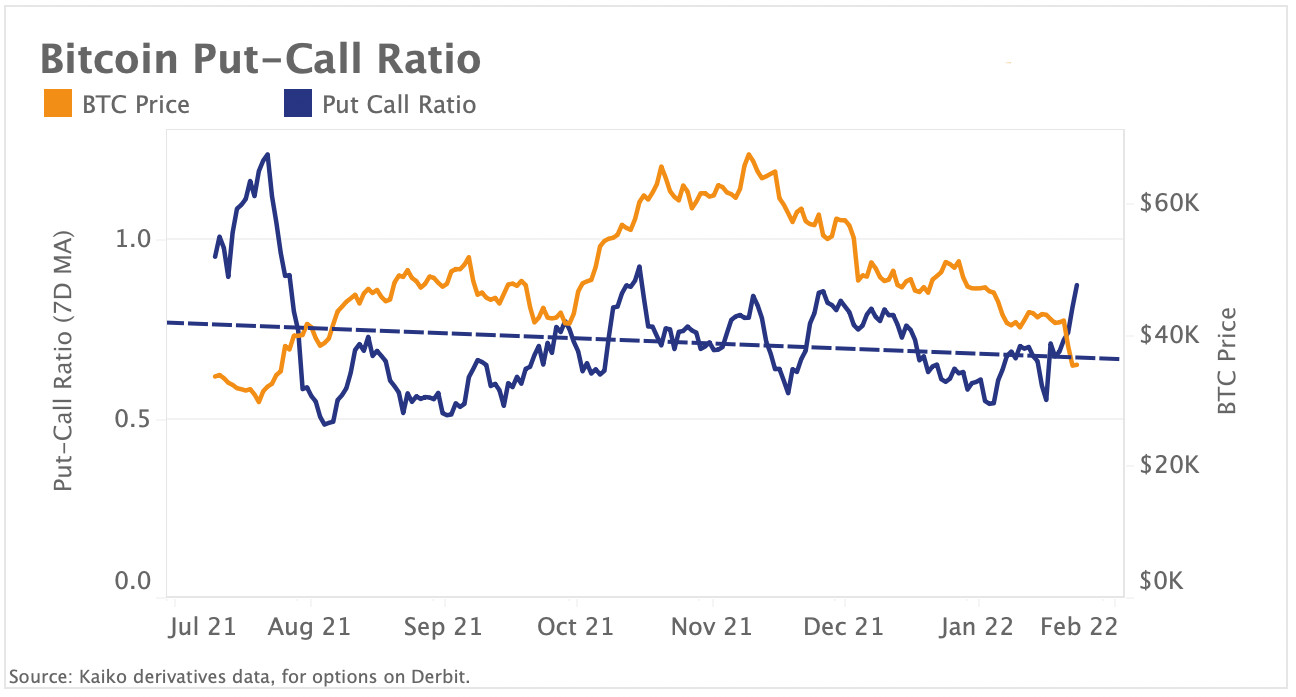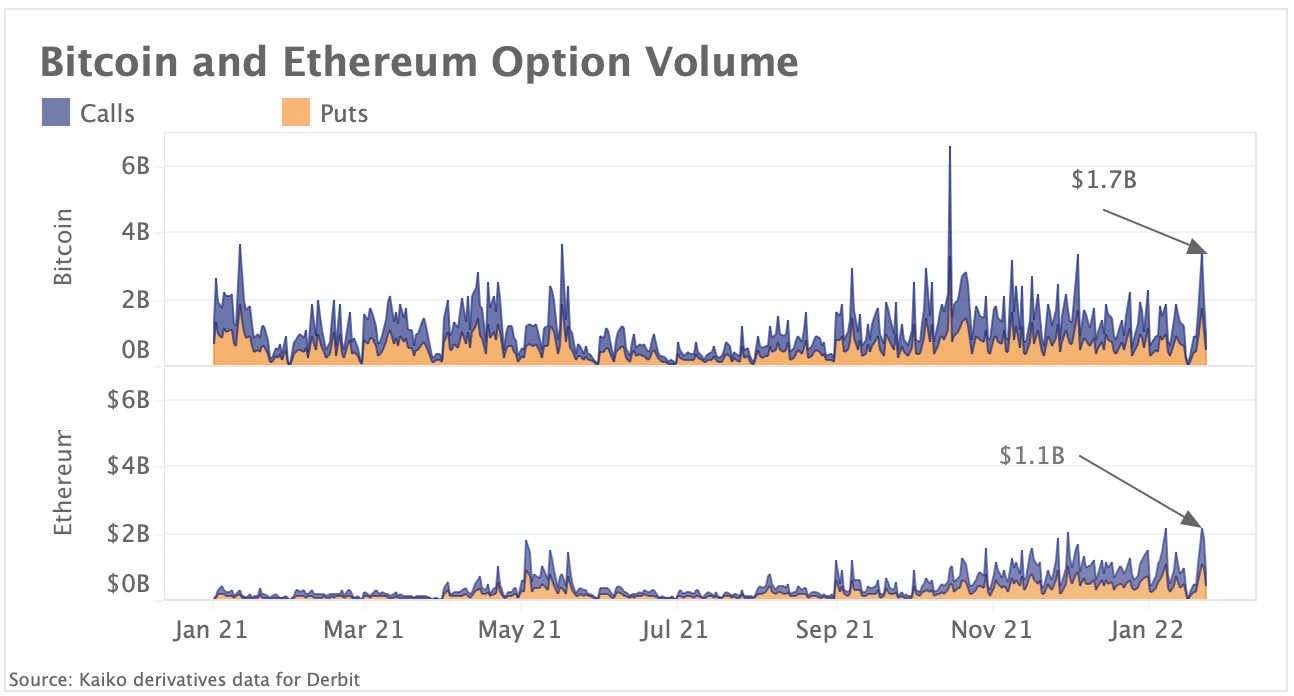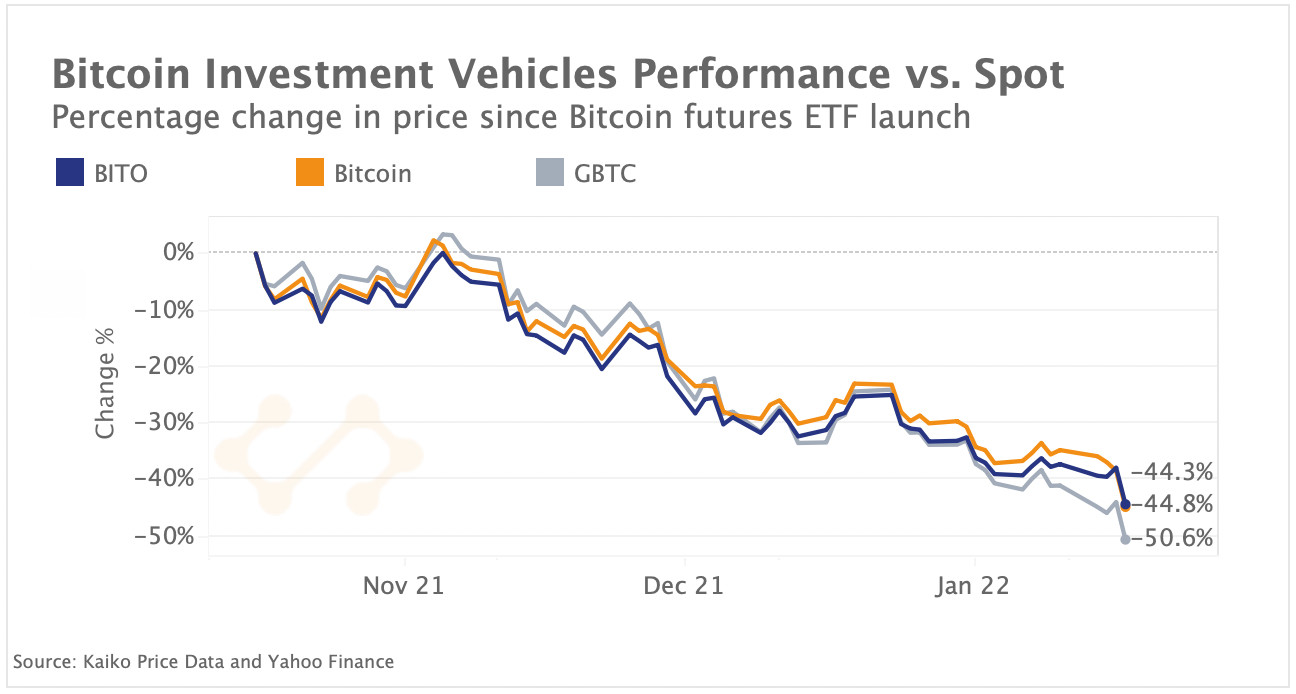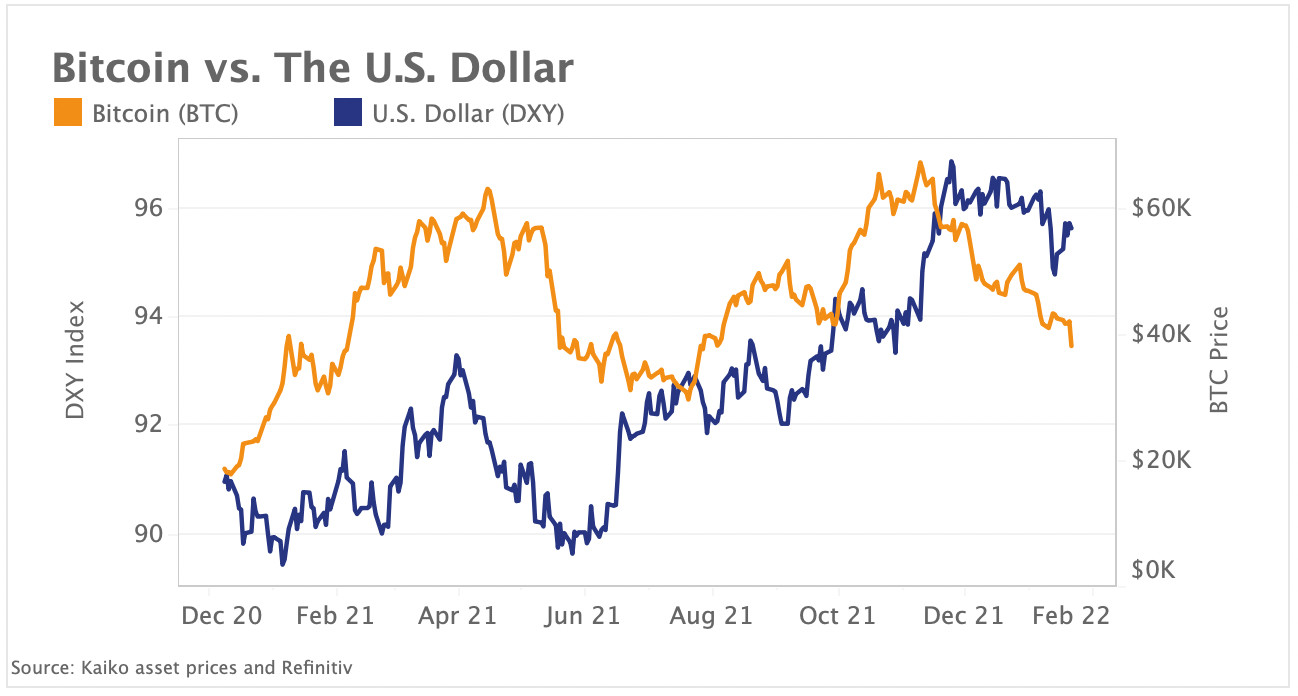A summarizing review of what has been happening at the crypto markets of the past week. A look at trending sectors, liquidity, volatility, spreads and more. The weekly report in cooperation with market data provider Kaiko.
The last 7 days in cryptocurrency markets:
- Price Movements: Bitcoin is down more than 45% since previous all time highs.
- Volume Dynamics: The number of new BTC-denominated trading pairs has plummeted since 2019 alongside the rise of stablecoins.
- Order Book Liquidity: FTX's liquidity as measured by the bid-ask spread has improved drastically over the past year.
- Derivatives: Ethereum options volume on Deribit hit a record high as markets flipped bearish.
- Macro Trends: Shares of the GBTC trust traded at a record low discount to Bitcoin spot last week.
Crypto and tech stocks in a correction phase
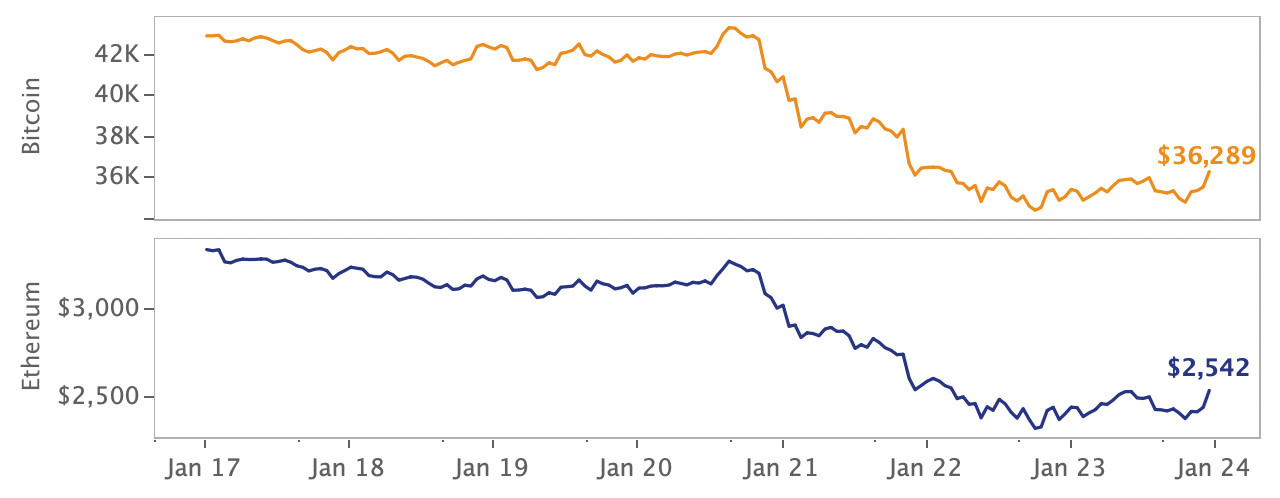
It was a sea of red across all financial markets, with Bitcoin closing the week down 15% and the Nasdaq hitting 6 month lows following a rocky start to earnings season. The steep sell-off in tech stocks along with growing macro anxiety ahead of the Fed’s upcoming meeting rattled cryptocurrency markets, sparing no large-cap or altcoin. Structured crypto products have also struggled considerably over the past few weeks, with the GBTC discount extending to new lows and ETF's experiencing net outflows. On the regulatory front, the Fed released their much anticipated report on CBDCs, Russia suggested a ban on all crypto activities, an EU market regulator called to ban proof-of-work mining, and US lawmakers held a hearing on crypto’s environmental impact.
Double-digit losses since previous all time highs
Crypto assets are well in correction territory along with traditional financial markets, with the top 100 crypto assets by marketcap all ending the week in the red. Above, we chart the percentage change relative to previous all-time highs for top crypto assets, compared with the S&P 500 and Nasdaq. Nasdaq is down ~15% since previous highs reached in November, while Bitcoin and Ethereum are down more than 40% from their peaks. Cosmos’ ATOM, Terra's LUNA, and Binance Coin (BNB), which all performed well in December, registered the smallest declines relative to other crypto assets. Dogecoin (DOGE), Ripple (XRP) and the governance tokens of DEXs Uniswap and Sushiswap were the worst performers, with corrections of nearly 80%.
BTC spot volume spikes during sell-off
Bitcoin spot trading volumes have been subdued since November alongside a bearish move in BTC prices. However, last week's volatility caused volumes to spike to their highest level since the December 4th sell-off. Overall, average daily volumes on the top cryptocurrency exchanges have hovered below $5b over the past month, down significantly since early Fall. The majority of spot volume still occurs on Binance, but recently Coinbase and FTX have been capturing more market share. Okex and Huobi have suffered most since the regulatory crackdown in China.
Stablecoin popularity continues to surge
Bitcoin was once the dominant quote asset in cryptocurrency markets, but over the past few years stablecoins have become the most popular denominating currency. The top stablecoins are all pegged to the U.S. Dollar, using collateralization by cash or securities as a stabilization mechanism, and are an important source of liquidity for cryptocurrency markets. Above, we chart the number of new instruments listed on all exchanges under Kaiko’s coverage denominated in Bitcoin, stablecoins and major fiat currencies. Until 2019, the majority of new instruments listed by exchanges were denominated in Bitcoin, but the trend has since reversed. Last year, stablecoin-denominated spot instruments accounted for nearly half of all instruments, while the share of instruments denominated in Bitcoin was only about 1/4.
We can also observe this trend when looking at the market share of trade volume on Binance, the largest cryptocurrency exchanges. BTC-quoted instruments have undergone a drastic fall in dominance since 2018, dropping from 90% of volume to just 10% .
As Bitcoin's market share slumped, Tether's surged and today denominates more than 73% of total volume. Binance USD - a USD-pegged stablecoin issued in collaboration between Binance and Paxos - has also gained market share, rising from nearly zero to 12% of total volume over the past two years. Fiat currencies on Binance only account for a fraction of total volume due to the limited number available, but their market share has increased considerably over the past year thanks to a surge in Turkish Lira volumes.
Open interest dips as BTC drops below $40k
Last week's market sell-off spurred more than $530mn of long liquidations across derivative markets as BTC dropped below the key $40k support level. Bitcoin perpetual futures open interest (charted above) fell by over 30% to around $12B with Bitmex and Binance registering the strongest drop in open contracts. Perpetual futures trade volume spiked during the sell-off, rising from $50B to $100B in a matter of hours. Markets have turned resolutely bearish with funding rates dipping negative on all exchanges.
Bitcoin option markets flip bearish
Bitcoin’s put-call ratio hit its highest level since October, suggesting growing bearishness among investors. Typically, traders buy call options to bet on price increases and seek protection via puts if they foresee price declines. A rising put-call ratio suggests demand for puts (bearish bets) is strengthening relative to demand for calls (bullish bets). Above, we chart Bitcoin options put-call ratio on Deribit, the largest cryptocurrency options market, along BTC spot price. We observe the put-call ratio has been on a steady upward trend in January after declining throughout December.
Option markets have matured over the past year with both Bitcoin and Ethereum options volumes remaining relatively high despite falling spot trade volume and prices.
In particular, Ethereum options volumes have surged since the start of 2021. Ethereum daily option volumes on the largest option market, Deribit, hit a record high of $1.1B on January 21, nearly equalling Bitcoin options volumes for the first time.
GBTC underperforms Bitcoin as discount hits record low
With Bitcoin's price falling by over 40% since it's all-time high in November, regulated investment offerings designed to provide exposure to crypto assets without owning it directly, have also taken a beating. Above, we chart the performance of two investment options relative to spot - the Proshares Bitcoin ETF (BITO) which tracks BTC futures prices and Grayscale Bitcoin Trust (GBTC) – the world’s largest crypto trust. While both products offer a convenient way to access the highly fragmented crypto market they have different trade-offs, illustrated by their tracking performance and fee model. We observe that since October 20th, GBTC has underperformed spot prices by 6% while BITO performed slightly better.
The launch of several future based ETFs in the U.S. over the past months, along with a growing number of alternative Bitcoin products worldwide has curtailed demand for GBTC. The Trust’s assets under management have declined from $32B in October to $27.5B currently and it has traded at a persistent discount to its Bitcoin holdings since February 2021. The discount, which hit a record high last week, could deepen further because ETF fees are less than half of GBTC’s, and its conversion to an ETF appears stalled.
BITO’s performance lagged spot in October due to the so-called “contango bleed”, a market condition when future prices are higher than spot, resulting in substantial roll costs. However, due to declining institutional appetite, the three-month CME bitcoin futures premium has declined significantly, briefly turning into discount (backwardation) which could be positive for Proshares returns.
The U.S. Dollar strengthens 7% since January 2021
The U.S. Dollar Index (DXY), which measures the performance of the greenback against a basket of six major currencies, ended the week in the green as the tech stock sell-off spurred a flight to safe havens. Overall, the U.S. Dollar has strengthened 7% over the past year as investors priced in several interest rate hikes in the U.S. for 2022. However, the Dollar has lost momentum over the past month, falling by 0.6% since the start of January, causing analysts to speculate that the U.S. currency has reached its peak.
Typically, the tightening of financial conditions and robust growth expectations in the U.S. should support the greenback. However, during previous hiking cycles historically the U.S. Dollar tends to rise in the months preceding a rate liftoff but declines in the months afterwards. This could be bullish for Bitcoin and U.S. equities, which have trended in the opposite direction as the Dollar since the start of pandemic-era monetary policy.


